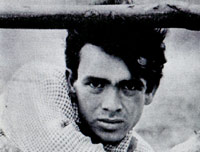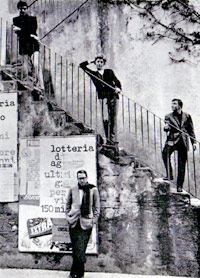 |
| WHATEVER HAPPENED TO... THE CLASS OF '62 |
 |
Way back in September 1962, Continental Film Review featured an article about 'The New Italians', a group of young directors making their first or second films that year. These filmmakers were seen as being the flag-holders for the Nouvelle Vague, a cinematic trend that was already grinding to an unceremonious halt in its native France. As the (unaccredited) writer argued: '… the French movement was essentially one of revolt, a reaction against the old stereotyped narrative film with its cumbersome methods of production and distribution. What they had to say was considerably less important than the way they said it. The Italians, on the other hand… are more politically conscious, more urgently concerned with the problems of the individual in an indifferent, corrupt and increasingly degenerate society.'
 |
Francesco Riuia (who he?) in Bertolucci's LA COMMARE SECCA |
What makes the article particularly fascinating is to look at the named directors and, with the benefit of hindsight, see how their respective career's bloomed, stalled or faded. To a certain extent, doing so acts as a window onto the Italian film industry, showing how it was to develop and decline over the subsequent four decades.
The individual whose name will be most familiar today is Bernardo Bertolucci. Back in 1962, he had progressed from being an assistant to Pasolini on Accatone to completing - at the age of just 21 - his first film, La commare secca (62). It hadn't proved to be an easy assignment: star Francesco Riuiu was arrested during filming, actress Marisa Solinas suffered from a 'nervous lapse' and, being unable to find an editor willing to take on the job, Bertolucci had to do it himself. If the film - a mystery revolving around the murder of a prostitute - is relatively unknown today, the director's other work is more familiar: The Last Emperor picked up Best Director & Adapted Screenplay Oscars, The Last Tango in Paris (Ultimo tango a Parigi, 72) remains a dirty favorite of film studies lecturers the world over and The Conformist (Il conformista, 70) is a true classic of its time.
 |
Giuseppe Patroni Griffi (bottom) with Dino Miele, Francoise Prevost and Unberto Orsini on location for THE SEA |
La commare secca competed at the Venice Film Festival for the 'first film' prize, where its main rival was Giuseppe Patroni Griffi's The Sea (Il mare, 62). Set in Capri, this was the story of a casual affair between a young actor and a woman who has been abandoned by her husband. It hardly set the box office alight, but Griffi went on to make a handful of films that featured a heady mix of sex and violence, the most familiar of which are 'Tis a Pity She's a Whore (Addio fratello crudele, 71) and The Trap (La gabbia, 86).
Eriprando Visconti was the son of an industrialist and the nephew of Luchino Visconti, for whom he had acted as assistant on Senso. His A Milanese Story (Una storia Milanese, 62) was a familiar tale of love between a wealthy boy (Enrico Thibaut) and a poor girl (Danielle Gaubert). It proved to be moderately successful, but very little of the director's subsequent work made much of an impact. The Awful Story of the Nun of Moza (La monaca di Monza, 69) was one of the first (and best) of the 'naughty nun' films that proved so popular in the early seventies; Der Kurier des Zaren an interesting adventure set in 19th century Russia starring John Philip Law. Visconti died in 1995 of emphysema.
More familiar is Giuliano Montaldo, who had first made a name for himself as an actor and who was much influenced by the 'co-operative filming' techniques of his mentor, Carlo Lizzani, and Giulio Pontecorvo. Tiro al piccione (62) was a war story about the partisans, and demonstrates a sympathy for popular cinema that is visible throughout his career. Subsequent films include the caper Grand Slam (Ad ogni costo, 67), Machine Gun McCain (Gli intoccabili, 68) and Sacco and Vanzetti (Sacco e Vanzetti, 71), all of which proved to be both critical and commercial hits. It seemed that he was going to be one of the few filmmakers to buck the industry decline of the seventies and eighties, but even his work has dried up in recent years. Time to Kill (Tempo di uccidere, 1990), is the last of his films to gain anything in the way of international distribution, and that was partly because it starred a young Nicholas Cage.
 CONTINUE TO PAGE 2 CONTINUE TO PAGE 2
If you would like to comment on this article, please go to the 'Directors of '62' thread in our forums.
|

